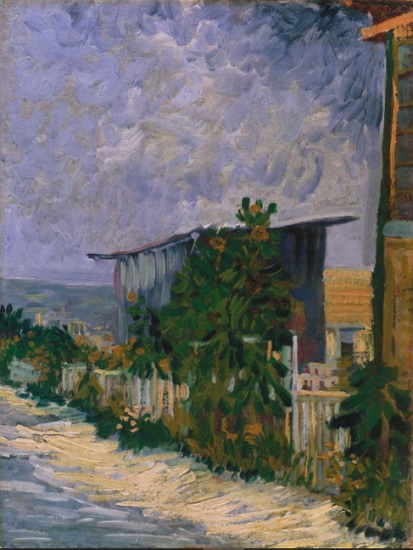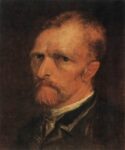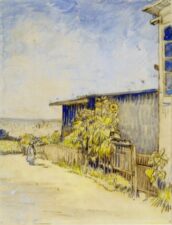
Vincent Van Gogh
Dutch, 1853 - 1890 (active France)
Shelter on Montmartre, 1886
oil on canvas
14 x 10 3/4 in.
Fine Arts Museums of San Francisco,
Bequest of Frederick J. Hellman

Van Gogh - Self-Portrait, Autumn 1886
“In Antwerp I did not even know what the Impressionists were, now I have seen them and though not being one of the club, yet I have much admired certain Impressionist pictures – Degas, nude figure – Claude Monet, landscape. And now for what regards what I myself have been doing, I have made a series of color studies in painting simply flowers, seeking oppositions of blue with orange, red and green, yellow and violet, seeking the broken and neutral tones to harmonize brutal extremes. Trying to render intense color and not grey harmony.” - Letter to Horace Mann Livens, September or October 1886

This watercolor, "Path in Montmartre with Sunflowers", is a fresh, sunny landscape, where a single sunflower, however insignificant in the context of the total composition, still attracts attention as the only warm yellow note. It clearly was the first study for "Shelter on Montmartre". - Jan Hulsker, The New Complete Van Gogh, Amsterdam: J. M. Meulenhoff, 1996, 288
COMMENTS
Vincent had time to accustom himself to the modern painting that Theo liked so much but which rather shocked him when he first arrived in Paris. “People have heard of the Impressionists, they have great expectations of them . . . and when they see them for the first time they’re bitterly, bitterly disappointed and find them careless, ugly, badly painted, badly drawn, bad in color, everything that’s miserable”. All the same, he realized that he would have to conform if he was to count for anything, or as he later put it: “It’s as necessary now to pass through Impressionism properly as it once was to go through a Paris studio”. Since his way of painting did not have very much in common with the latest developments, it is not surprising that at first he sought refuge in the oeuvre of an artist who had one foot in the first half of the nineteenth century and the other in the second half: Adolphe Monticelli, a little-known Provencal artist, who worked with bold colors but, unlike the Impressionists, painted on dark wooden panels, which made his colors far more sunken than the new generation’s. His multicolored works were reminiscent of the colored tissues that van Gogh liked so much, and his “single flow of impasto” was something to be jealous of.
Thanks to Monticelli’s example, van Gogh learned how to be far more abstract in his touches of color than he had ever been in his Dutch period. His work became far less detailed and descriptive, but although he made great progress as a colorist, and admitted shortly afterward that he even admired “certain Impressionist pictures—Degas, nude figure—Claude Monet, landscape,” he still did not belong to their “club” by the autumn of 1886. Or to put it another way, he was still building up his scenes on the basis of values and chiaroscuro, and not with color intensity, as the Neo-Impressionists claimed to do, nor did he use lightly primed canvases in order to achieve luminosity, as the classic Impressionists had done.
- Timothy J. Standring, Becoming van Gogh, Denver Art Museum, 2012, 34-35
SBMA CURATORIAL LABELS
The bustling suburb of Montmartre, where Van Gogh lived in his brother Theo’s apartment, had not yet been entirely annexed into the rapidly expanding city of Paris. The neighborhood included all the necessities for bohemian existence, including paint shops, artists’ studios, cafés, brothels, and entertainment spots. More often than not, Vincent still sought out more rural motifs such as this one, a small shed near an old farmhouse, located on the relatively undeveloped northwest side of the hill. Here we see clear evidence of Van Gogh’s assimilation of Impressionism in the sketch-like brushwork, applied to take full advantage of the contrast created by the complementary hues of blues and oranges.
- Through Vincent's Eyes, 2022
